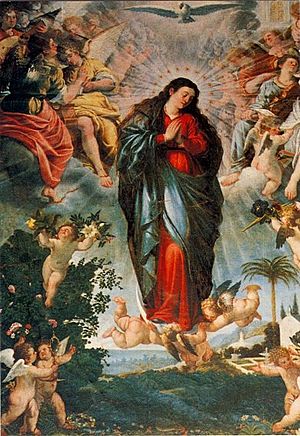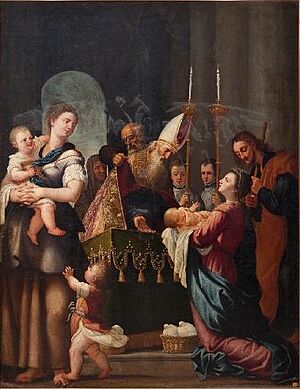Angelo Nardi facts for kids
Angelo Nardi da Razzo (born February 19, 1584 – died 1664) was an Italian painter. He lived during the early Baroque period. He is mostly known for his artwork created in Spain.
Contents
Angelo Nardi's Life and Art
Early Life and Training
Angelo Nardi was born in a town called Vaglia in Italy. His family was from Florence. He probably learned to paint from important artists. These artists were part of the Counter-reformation. This was a time when the Catholic Church was renewing itself.
From about 1600 to 1607, Angelo Nardi lived in Venice. After that, he moved to Madrid, Spain.
Moving to Spain and Early Works
By 1615, Nardi was asked to paint a series of artworks. These paintings celebrated a meeting of Spanish and French royal families. Sadly, these paintings were destroyed in a fire in 1734. The fire happened at the Royal Alcázar of Madrid.
Between 1619 and 1620, he created many works for a convent. This was the Convento de las Bernardas in Alcalá de Henares. He made these paintings after the founder of the convent, Bernardo de Sandoval y Rojas, passed away. These works are seen as his first truly great paintings.
Becoming a Court Painter
Around this time, Nardi also managed a painting workshop. After the workshop owner passed away in 1620, Nardi took over the studio. In 1623, he married the owner's young daughter. This marriage later ended in 1625. Soon after, he received an important job. He became a Painter to the King. This was mostly an honorary position, meaning it was unpaid.
In 1627, another court painter, Bartolomé González, died. This created an opening for a new court painter. Nardi finally got this job in 1631. He had some strong competition, including Diego Velázquez. Velázquez also received a similar job. Over time, Nardi and Velázquez became good friends. Nardi even helped Velázquez when he was being considered for the Order of Santiago.
Once Nardi's financial situation was stable, he painted for religious groups. He also helped other painters. He managed to get them an exemption from a sales tax called the alcabala.
Angelo Nardi passed away in Madrid. He was buried at the Church of the Misericordia. This church was destroyed during the Spanish Civil War. There is a street in Vaglia, Italy, named after him.
Selected Artworks
Here are some of Angelo Nardi's famous paintings:
- Crucifixión (for the Carmelite order, Alcalá de Henares)
- Escenas de la Vida de Santa Teresa de Jesús (for the Carmelite order)
- Fresco decorations at the Chapel of the Conception, La Guardia (around 1630)
- Noli me tangere (1639, Getafe)
- Escenas de la Vida de la Magdalena (1639, Alcalá de Henares archives)
- San Jerónimo (Saint Jerome) (Biblioteca Museu Víctor Balaguer)
- San José con el Niño y san Juanito (Museo del Prado)
- Presentación de Jesús en el Templo (Museo de Prado, Huesca)
- Retablo de las Claras (1647, Alcalá de Henares)
- Adoración de los Pastores (Adoration of the Shepherds) (1650, private collection)
See also
 In Spanish: Angelo Nardi para niños
In Spanish: Angelo Nardi para niños



